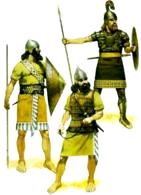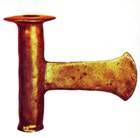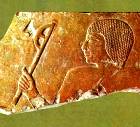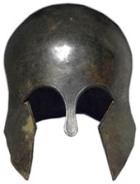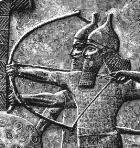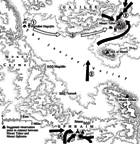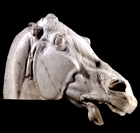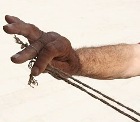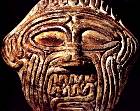War in ancient Israel
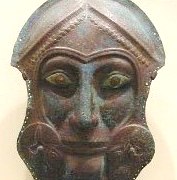 How did an ancient war begin?
How did an ancient war begin?
War in the Bible lands was not formally declared as it is today. A commander would simply
- pitch his camp in enemy country
- show the strength of his army and then
- lay down conditions which, if met, would prevent hostilities (I Samuel 11:1).
Sometimes the actual combat would be left to selected champions, as in the story of David and Goliath.
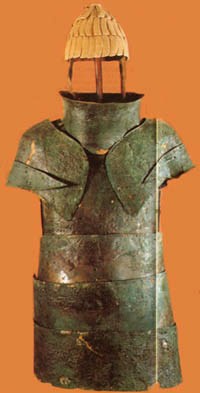
No Israelite armor has been found, but this Greek armor was made for a soldier in the mid 1st millennium BC
Or a challenge could be issued from one ruler to another, as Amaziah of Judah did to Jehoash of Israel in II Kings 14:8-10 – but this was unusual.
A siege – the war begins
Deuteronomy 20:10-20 lays down the rules for a siege.
Before beginning the siege of a town in foreign territory, the Israelites had to offer peace terms.
- If these were accepted and the gates opened, the population might be put to forced labour (not slavery or death) and the town occupied.
- If these were rejected, and the city fought back and was defeated, then the men might be put to death and all the women, children and property taken as booty and divided among the victors.
However, for the towns of foreigners within Israelite territory, much harsher measures were laid down: ‘you shall save alive nothing that breathes’ (Deuteronomy 20:16).
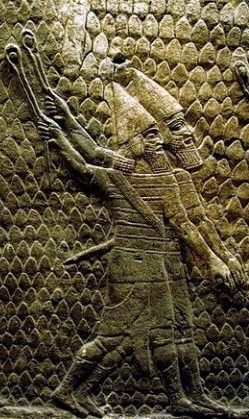
Assyrian slingmen
This sounds horrific, but in fact the Israelites were no more cruel to the defeated than other nations. In fact, the treatment they meted out to a captured town was far less ferocious than the calculated brutality of the Assyrians.
Sharing the spoils of war
The booty of a victory was divided among the soldiers, with special shares going to the officers.
Here’s a curious fact: soldiers left behind to guard the camp shared equally with those who fought in the battle.
As well, a heavy indemnity or yearly tax might be imposed on a conquered people – or on the survivors, of course.
What were ancient battles like?
The Bible has no great set-piece battles like those of Alexander or Napoleon. If they happened, the Bible does not describe them.
Very little is known about the deployment of troops during any particular battle – the Bible describes
- the reasons for the battle
- who was involved
- and what the result was
- but it tells us virtually nothing of the strategies used by the opposing generals.
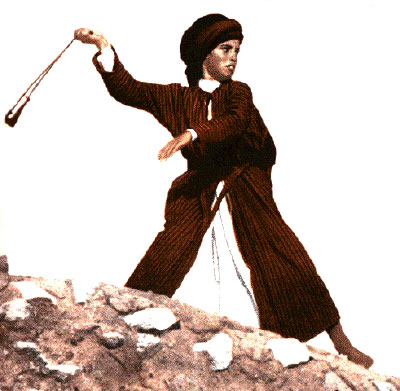 In the early days before the reign of David, fighting consisted of skirmishes or raids.
In the early days before the reign of David, fighting consisted of skirmishes or raids.
The Israelites were experts at guerilla fighting, relying on surprise attacks to panic their enemies.
These battles fall into two groups – roughly before the reign of David, and after it.
Before King David
- the campaigns of Joshua
- Ehud versus the Moabite king Eglon (Judges 3:12-30)
- Deborah and Barak versus Jabin of Hazor and Sisera (Judges 4 and 5)
- Gideon versus the Midianites (Judges 7:1-25)
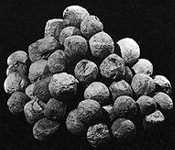
A cache of slingshots found in the ruins of Lachish
- Samson versus the Philistines (Judges 13:1-16:31).
These were all defensive battles fought with tribal militia. They were more like extended skirmishes, lasting minutes to hours – short, sharp, swift.
From King Saul to the Exile
- Saul’s war with the Philistines
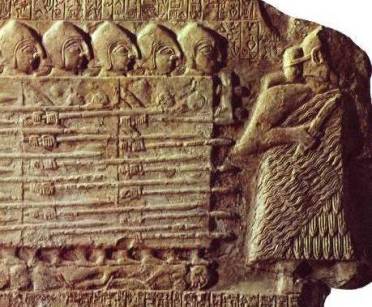
Eannatum, King of Lagash,
leads his troops into battle - David’s victories against his many enemies
- Israel under two great military kings, Omri and Ahab – the Battle of Qarqar
- the battle against the Egyptians at Megiddo, King Josiah killed
- the siege of Samaria, and
- the conquest by Sargon II of Assyria after a three-year siege.
What was the Israelite Army like?
In the early part of Israel’s history, each tribe provided a militia from its able-bodied men. This group was willing and able to fight, and had received some training. They were not a regular army as we understand the term, not full-time soldiers, but men who were called on to defend their clan whenever there was a need – somewhat like the men who fought for Scotland in the Battle of Culloden.
In the battle scenes in the movie ‘Braveheart’, William Wallace led a federation of clans/tribes. Each clan could leave or change sides if they wished.
That was the pattern for the Israelite army. The tribes were often motivated by self-interest, which is fair enough if its men were going to face death in battle.
But this system could be a problem for a leader trying to muster a large force and hold it together – as Deborah had to do when her general Barak mustered the tribes to face the well-trained and organized Canaanite army of Sisera (for the story of this battle, see Deborah and Barak.
- The advantage of militia is that the men will fight passionately for their home and families.
- The disadvantage is that they cannot be held for long-term wars or fighting. At harvest time, for example, men often simply downed their weapons and returned home to bring in the harvest.
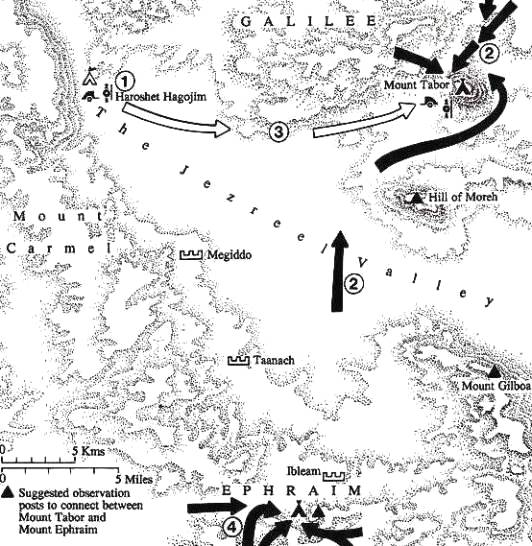
(Above) The terrain for the battle between Deborah and Sisera. Plan of the first phase of the battle between Deborah’s forces and Sisera. 1: Sisera’s base camp; 2: Deborah and Barak concentrate their forces on Mt. Tabor; 3: Sisera moves to invest Mt. Tabor; 4: the second Israelite force concentrates near the northern slopes of Mt. Ephraim. From ‘Battles of the Bible’, Chaim Herzog and Mordechai Gishon.
The chariots of the well-organised and equipped Canaanite army were useless in the boggy marsh of the Jezreel Valley – it had recently poured with rain. The lightly armed and mobile Israelite militia used their slingmen and archers to pick off the enemy soldiers.
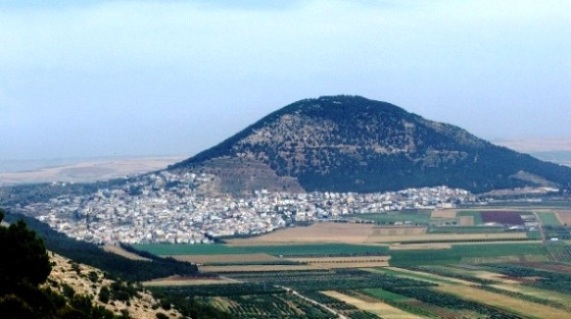
Mount Tabor and the Jezreel Valley below, scene of the battle between Deborah/Barak’s forces and Sisera, the fearsome general of King Jabor of Hazor (see Judges 4 and 5). Jabor and his general Sisera counted on their iron-wheeled chariots, effective on the flat plain below Mount Tabor. What they did not foresee was the torrential rain that turned the ground into a quagmire, giving the lightly armed Israelites the advantage.
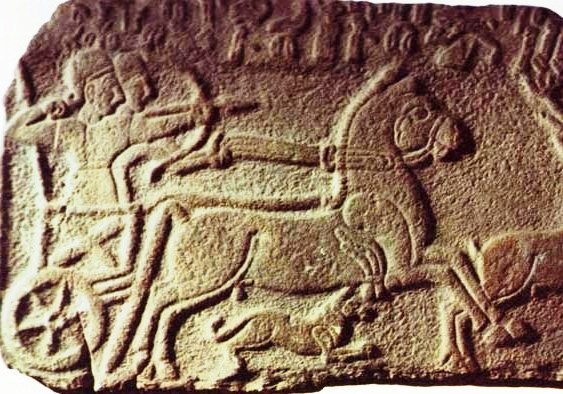
The iron-wheeled chariots of the Canaanite troops.
Despite their undoubted courage, the tribal militias were not really successful.
Their enemies, such as the Philistines, were well-organized – 1 Samuel 4:2 tells us that the Philistines were drawn up in lines when they attacked Israel, which suggests a disciplined, well-trained enemy.
Moreover, the Israelites were poorly equipped, with little or no armor.
The Israelite army reorganized
When King Saul, and then King David and his son King Solomon took the throne, there was a dramatic change. These kings began to copy the strategies of their enemies.
David had fought Goliath with nothing but a sling and his wits. (Read about David’s use of lateral thinking at Young Heroes of the Bible.)
But later when he became king, he took care to organize and equip an army that would have a better chance of defeating its enemy.
- He and the kings who followed him had regular armies with full-time trained soldiers.
- They used new strategies and tactics, things that worked well for their enemies – for example, laying siege to a city.
- But they also held onto the tactics that had worked for them before: surprise attacks, psychological warfare, propaganda.
Note: Very little is known about the organization of the army under the Israelite kings. When the Bible speaks of soldiers in ‘thousands’, it does not mean numerical thousands. ‘Thousands’ is a term describing a unit of soldiers.
Unfortunately, we do not know how many soldiers would have been in one of these units – but certainly it would have been much, much less than a numerical ‘thousand’.
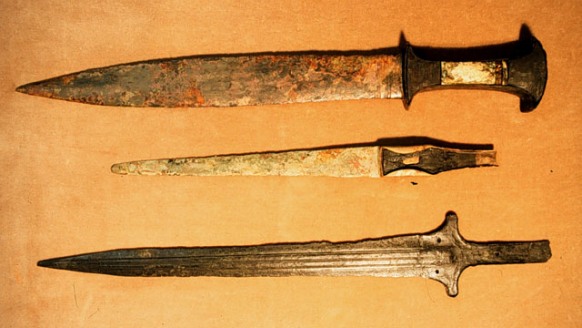
Canaanite sickle sword and straight swords.
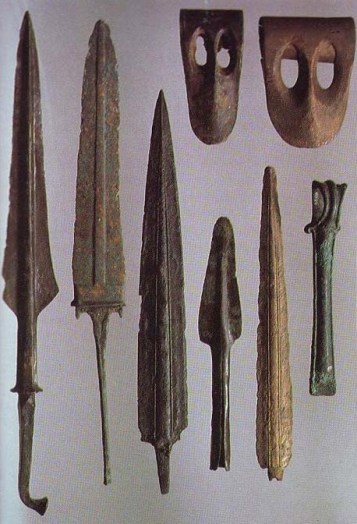
Assorted metal weapons
What weapons did Bible soldiers use?
There were four branches in the army:
Weapons used by these groups can be divided into two groups:
- those the soldier held and wielded at close quarters with the enemy
- those he projected, either with his arm or with the help of some other centrifugal force, for example the sling.

Heavy-armed archers in action. Assyrian, about 700-692 BC. From Nineveh, South-West Palace. These archers, the front one of whom is beardless, possibly a eunuch, are accompanied by a soldier who holds the shield in position and guards against enemies who come too close.
There are few references to weapons in the period of the Judges, or in the battles that were fought then – no Israelite spears, bows, shields, javelins, axes or maces – or the protective body armor (see Judges 5:8).
Their enemies, on the other hand, were well armed – Goliath had a full suit of armor.
The Assyrian archers at right had not only their bows and arrows, but full body armor, helmets and large wicker shields to protect them.
After the introduction of the monarchy by Saul, David and Solomon, weapons became much more common. The standing army was equipped with effective weapons, and when the Philistine control over the manufacture of metal was broken, the weapons industry of Israel came under the control of the king.
Hand held weapons included
- the sword,
- the mace or club, and
- spears and javelins.
- projectile weapons using centrifugal force included the bow and arrow, and the sling. The slingers were probably more accurate at hitting their target than the archers.
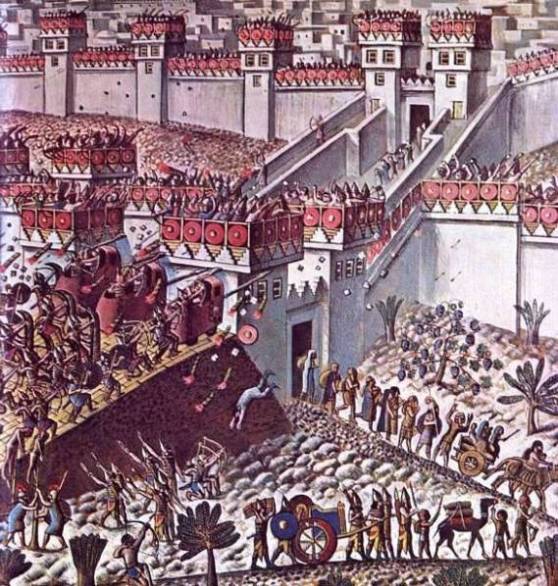
A reconstruction of the final attack on Lachish, showing the chaos of an attack on a walled city. The city is protected by strong walls; battering rams attack the city gates, middle left; slingers, archers and impaled captives are in the bottom left corner of the picture; captives and loot are taken from the city, middle right and bottom.
Military engineering, siege warfare
Sun Tzu, the great Chinese war tactician, said ‘The worst policy is to attack cities. Attack them only when there is no alternative.’
He knew that attacking, or even laying siege to a city, was expensive and time-consuming, so he did not favor it.
That’s all very well, but what if you don’t have the numbers for open warfare?
Siege warfare was the method Joshua frequently used in the story of the infiltration of Canaan, since he lacked the numbers to face an enemy in open battle.
Siege warfare was also practised by Abimelech at Shechem, and Jephtah also used it in Ammon.
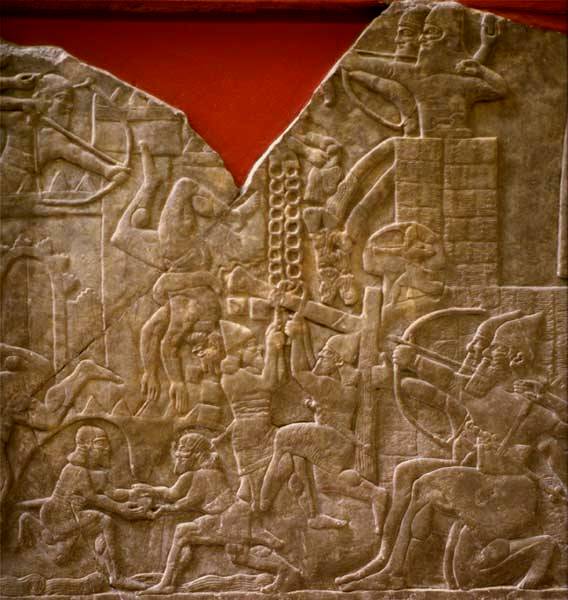
A siege machine used by Sennacherib against the walls of Lachish
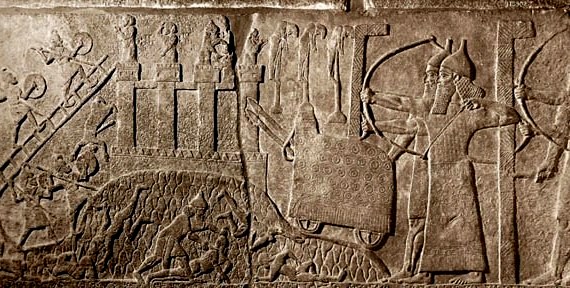
Wall relief from the palace of Nimrud, showing Assyrian soldiers attacking the city of Lachish. Note the sappers undermining the wall foundations, the impaled captives, the battering ram and the archers armed with composite bows
Siege warfare may have been expensive and time-consuming, but it was also effective. The great empires of the ancient Near East perfected it.
- The Assyrians developed specialized storm troops who were able to take advantage of any breaches in the wall.
- Trained sappers built zig-zag trenches allowing their own soldiers to get closer to the walls of the besieged city, without being hit by missiles coming from the city.
- Their engineers developed new siege weapons such as covered battering rams and mining tools.
- Then the attackers would seal off the city under attack by encircling it with their army.
The soldiers would settle down to wait, but it was a busy time for the engineers, who would begin building siege works. An earthen wall might be built to encircle the city; it would have guard towers at regular intervals, to keep watch for breakouts.
Siege ramps made of earth and wood would be built as soon as the battering rams (see below) were ready for use.
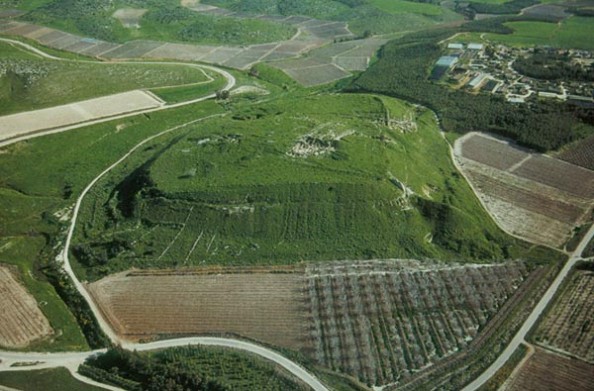
An aerial view of the tel of Lachish, once a flourishing city. The siege ramp is clearly visible at the bottom right of the tel. The excavated remains of the royal palace are in the centre of the tel.
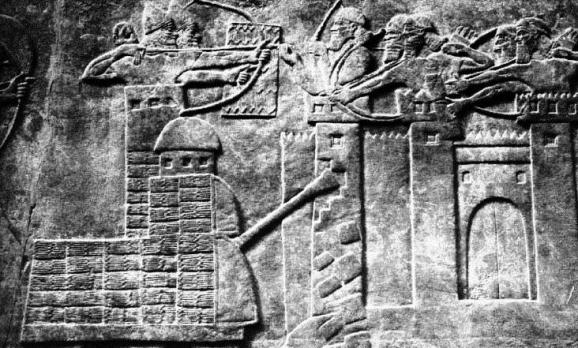
The city of Lachish under attack, with the battering ram doing its deadly work.
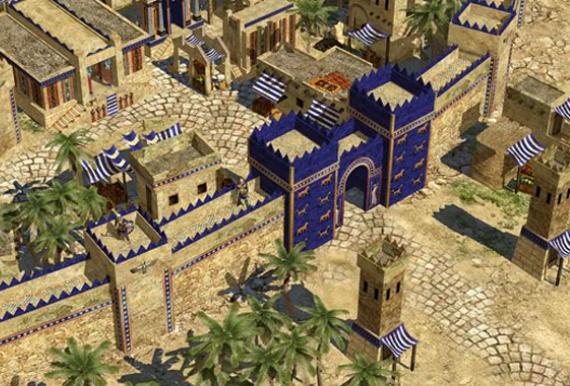
The reconstructed city gates of Babylon, shown in the drawing above, are similar to the gates of Lachish. But any city under siege for months, perhaps years, would not have looked as attractive as this. Isaiah comments that ‘their corpses were as refuse in the midst of the streets’ (5:25)
Unless relief came from outside, the inhabitants of the city were trapped. All they could look forward to was starvation, surrender, slavery or death – and probably a horrible death at that.
Jeremiah describes some of the terrible things that happened during a siege: ‘I will make them eat the flesh of their sons and their daughters, and everyone shall eat the flesh of his neighbor in the siege.’
Summary
Unfortunately for Israel it lay at a strategic crossroad, straddling major trade routes and wedged between two great empires, Sumeria/Assyria on the one hand, and Egypt on the other.
So it often became a battlefield when foreign troops passed through on their way to somewhere else.
War was part of life in ancient Israel, though the way it was waged changed drastically in the time between 1300-586BC.
- At first the soldiers were voluntary militia,
- they later became an organized and disciplined army.
- finally, some thirty or forty years after the death of Christ, they were a desperate, defensive force against the Roman invaders.
‘For everything there is a season..
a time for war, and a time for peace.
(Ecclesiastes 3.1-8.)
Search Box
![]()
Bible wars – links
© Copyright 2006
Elizabeth Fletcher


